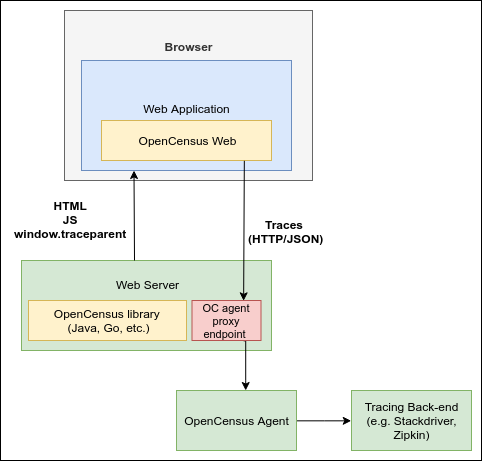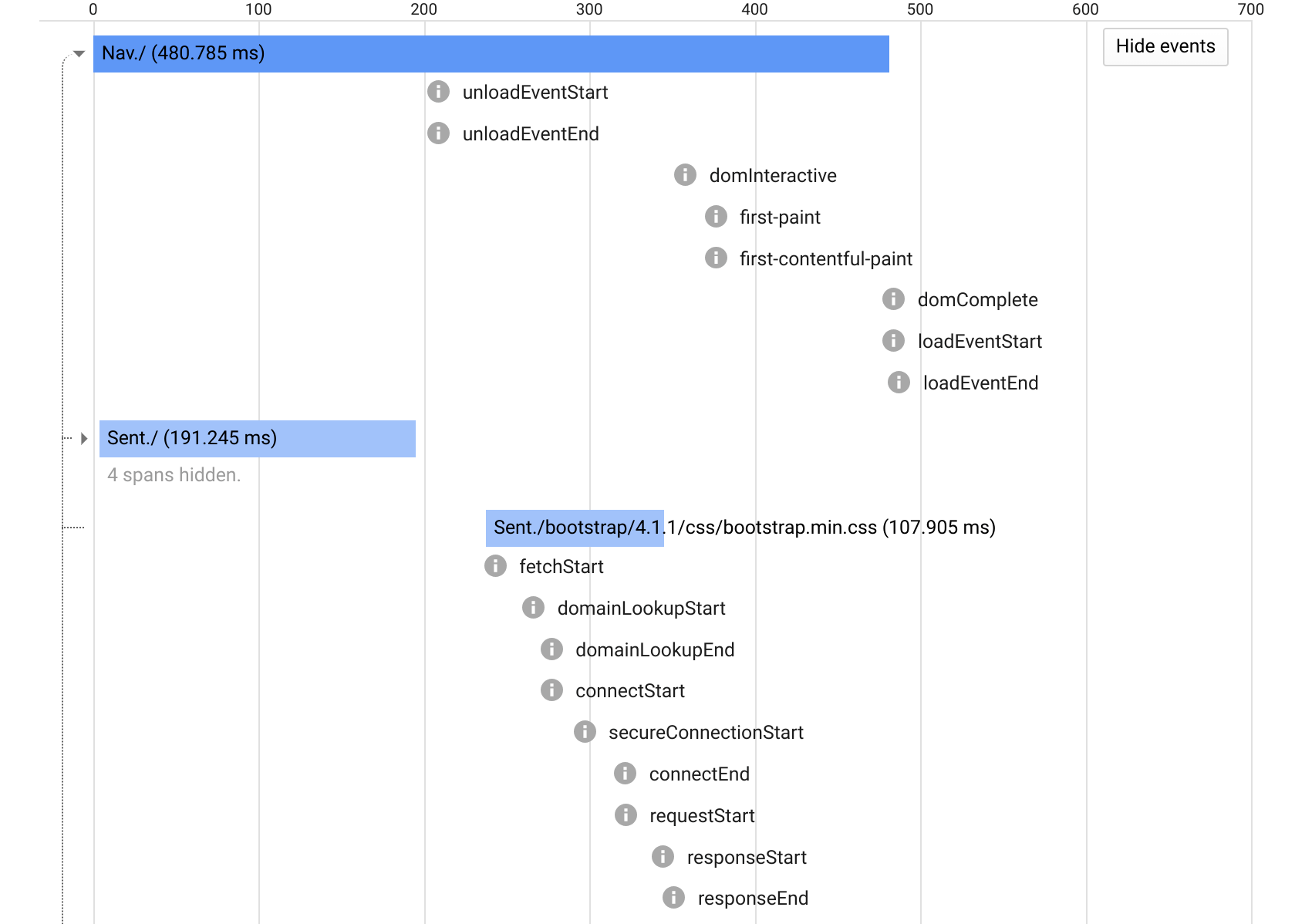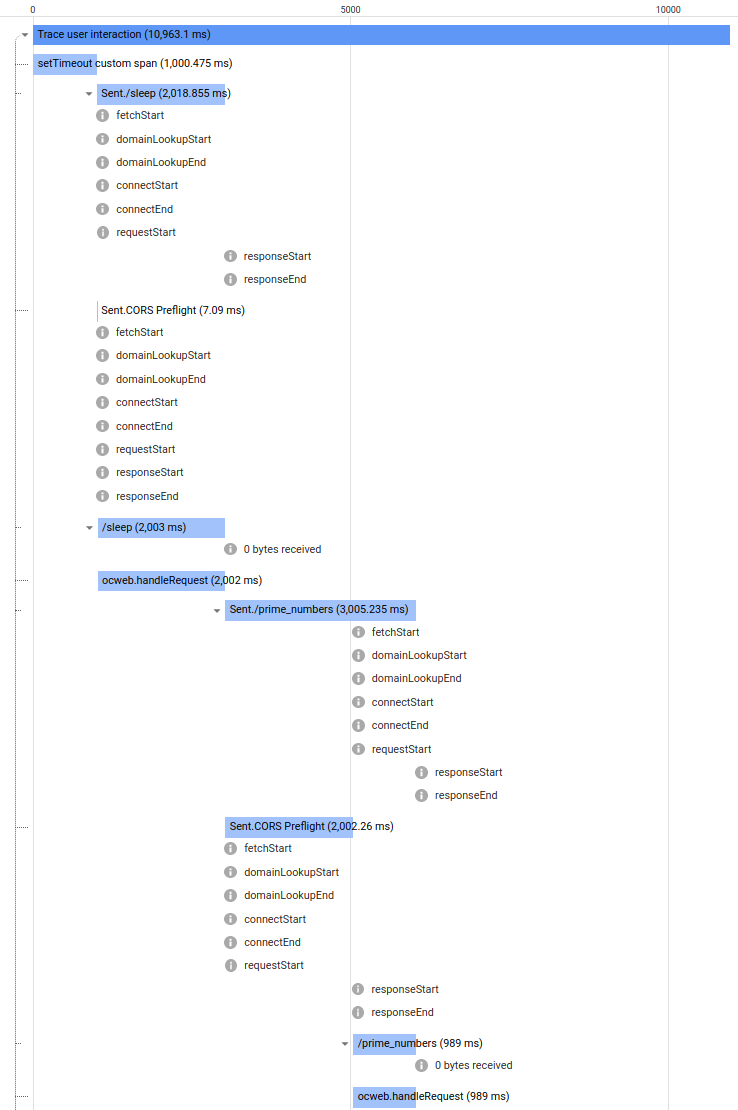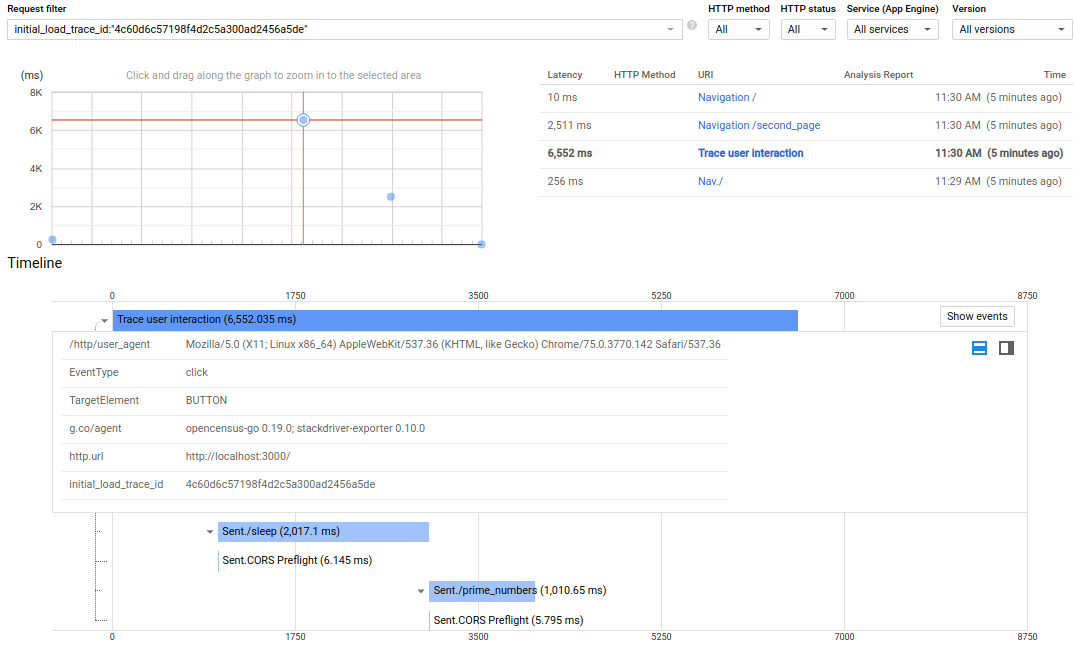OpenCensus Web is an implementation of OpenCensus, a toolkit for collecting application performance and behavior monitoring data. This library instruments browser applications to collect user-side performance data.
The library is in alpha stage and the API is subject to change.
Please join gitter for help or feedback on this project.
OpenCensus Web instruments web applications generates traces for the initial page load of a site in the browser and the subsequent on-page user interactions after the initial load. Some features that also provides are automatic tracing for clicks and route transitions, custom spans, and browser Resource Timing API data.
It supports sending the trace sampling decision and trace ID from the web server to the browser client to enable latency debugging across the stack.
OpenCensus Web interacts with three application components:
-
Frontend web server: renders the initial HTML to the browser including the OpenCensus Web library code and the necessary configuration (e.g. window.ocAgent). This server would typically be instrumented with an OpenCensus server-side library (Go, Java, etc.) that can attach the server-side spans to the trace, that is sending the Trace Context Header in the W3C draft format via a
window.traceparentglobal variable. We also suggest that you create an endpoint in the server that receives the HTTP/JSON traces and proxies to the OpenCensus Agent. -
Browser JS: the OpenCensus Web library code that runs in the browser. This measures user interactions and collects browser data and writes them to the OpenCensus Agent as spans via HTTP/JSON.
-
OpenCensus Agent: receives traces from either the frontend web server proxy endpoint or directly from the browser JS, depending on the way you deploy it, and exports them to a trace backend (e.g. Stackdriver, Zipkin).
Here's a sample trace from OpenCensus Web that was exported to
Zipkin. Notice that there is an overall nav./ span for the user
navigation experience until the browser load event fires. There are also
/ spans for the client and server side measurements of the initial HTML load.
The server side spans also indicates how much time was spent parsing and
rendering the template:
These spans are generated via the browser's
Navigation Timing and
Resource Timing APIs. Notice also the long js task
span, which indicates a CPU-bound JavaScript event loop that took more than 50ms
as measured by the Long Tasks browser API.
The OpenCensus Web spans also include detailed annotations for DOM load events
like domInteractive and first-paint, as well as network events like
domainLookupStart and secureConnectionStart. Here is a similar trace
exported to Stackdriver Trace with the annotations
expanded:
These annotations also comine from the Resource Timing API. Note that for resources fetched via CORS, you will need to specify the Timing-Allow-Origin header.
OpenCensus Web automatically traces all the click events as long as the click is done in a DOM element (e.g. button) and it is not disabled. When the user clicks an element, an interaction is started to measure all the synchronous and asynchronous code that this interaction may trigger, like network calls or JS code execution.
OC Web provides the option of adding the attribute data-ocweb-id to HTML elements and give a custom name
to the interaction. For the next example, the resulting name will be ‘Save edit user info’:
<button type="submit" data-ocweb-id="Save edit user info"> Save changes </button>In case you don’t add this attribute, OC web will use the DOM element ID, the tag name plus the event name involved in the interaction to generate a CSS selector name. For example, clicking this button:
<button id="save_changes"> Save changes </button>would generate a span named: 'button#save_changes click'.
OC Web traces route transitions between the different sections of your page by monkey-patching the History API. OC Web names this kind of interaction as ‘Navigation /path/to/page’. The following trace exported to Stackdriver Trace shows a span named Navigation /second_page which involves some network calls before the route transition is complete:
Instrument your web application with custom spans for tasks or code involved in a user interaction. Here is a code snippet in JavaScript that shows how to do this with the npm package dependency:
import { tracing } from '@opencensus/web-instrumentation-zone';
function handleClick() {
// Start child span which will be child of the current root span on the current interaction.
// To make sure the span is attached to the root span, add this in code that the button is running.
const childSpan = tracing.tracer.startChildSpan({
name: 'name of your child span'
});
// Do some operation...
// Finish the child span at the end of it's operation
childSpan.end();
}
// Create a fake button to point out the custom span is created in the click handler.
const button = document.createElement('button');
button.onclick = handleClick;OC Web intercepts HTTP requests generated by an interaction (specifically XMLHttpRequest objects)
to automatically create a span for this HTTP request and measure it. Additionally, OC Web sends along
the HTTP request a Trace Context Header in the W3C Trace Context format to the server
as long as the URL is the same origin or matches a provided regex. To provide this Regex,
add the ocTraceHeaderHostRegex global variable.
In case the server is instrumented with OpenCensus, you can see attached the spans coming from the server and be able to know the server performance as well. This lets you know if the issues are related to either the front-end or the server-side.
OC Web also includes Performance Resource Timing API data to make annotations like
domainLookupStart and responseEnd, also, generates spans for any CORS preflight requests.
The next screenshot shows a trace exported to Stackdriver Trace. Notice the several network calls with the automatic generated spans (e.g. ‘Sent./sleep’) with the respective annotations. Also, there are server-side spans (e.g. ‘/sleep’ and ‘ocweb.handlerequest’) and CORS Preflight related spans.
OC Web attaches the initial page load trace id to the user interactions as an attribute and a span link. This enables search by attribute to find the initial load trace and the interaction traces happening after the initial load via a single attribute query.
The next screenshot from Stackdriver Trace shows a search by initial_load_trace_id attribute containing all
user interaction traces after the initial page loaded.
The OpenCensus Web library exports traces via the OpenCensus Agent, which can then export them to a variety of trace backends. See the OpenCensus Agent/Collector exporter docs for details.
Below are the steps that are currently needed to use it.
The OpenCensus Web library currently only exports traces via the OpenCensus Agent, which can then export them to a trace backend (e.g. Zipkin, Stackdriver). See this example's README for steps to run the agent locally or in the cloud.
When you run the agent in the cloud you will need to expose it to your application via the internet. You may also to proxy the agent behind the authentication or CSRF protection layer of your application to to only allow traces to be written by authenticated end users.
OpenCensus Web gives tree ways to use it in your application, where you can either only import the code for the initial page load tracing or the whole OpenCensus Web tracing including the initial page load and user interaction tracing.
See the examples/initial_load folder for a full example of how to use initial page load functionality in your application. Also, see the examples/user_interaction folder for a full example of how to also trace the user interactions.
You can use OpenCensus Web via a <script> tag that makes uses of the
<unpkg.com> CDN that serves files from NPM packages.
The script tag should go before the </body>. You will also need to set the
ocAgent endpoint in a different <script> and may also specify the
trace sample rate via an ocSampleRate global variable as well.
-
If you only want to use the initial page load functionality:
... <script> // HTTP endpoint of the OpenCensus Agent you ran and exposed to the internet // in Step 1 above. ocAgent = 'https://example.com/my-opencensus-agent-endpoint'; // Sample all requests for trace, which is useful when testing. // By default this is set to sample 1/10000 requests. ocSampleRate = 1.0; </script> <script src="https://unpkg.com/@opencensus/[email protected]/dist/initial-load-all.js" integrity="sha384-VPY9XX7tiXeLekDPFXkfO2AqNpLTCNOzfXxVghzoVP05PXrG+wtHOW2kOP2ggO9o" async crossorigin="anonymous"> </script> </body>
-
If you want to trace user interactions, you have two options: In addition to the previously explained variables, you need to set the
ocTraceHeaderHostRegexregex to tell the OC Web which HTTP requests can be intercepted in a interaction to send the Trace Context Header.... <script> // HTTP endpoint of the OpenCensus Agent you ran and exposed to the internet // in Step 1 above. ocAgent = 'https://example.com/my-opencensus-agent-endpoint'; // Sample all requests for trace, which is useful when testing. // By default this is set to sample 1/10000 requests. ocSampleRate = 1.0; // Send the trace header to all hosts. window.ocTraceHeaderHostRegex = /.*/; </script> ...
-
If your application doesn't already use the
Zone.jslibrary, the case for non-Angular apps (e.g. React, etc.):... <script src="https://unpkg.com/@opencensus/[email protected]/dist/tracing-all-with-zone.js" integrity="sha384-VPY9XX7tiXeLekDPFXkfO2AqNpLTCNOzfXxVghzoVP05PXrG+wtHOW2kOP2ggO9o" async crossorigin="anonymous"> </script> </body> -
If your application uses the
Zone.jslibrary, the case forAngularapps:... <script src="https://unpkg.com/@opencensus/[email protected]/dist/tracing-all-with-zone-peer-dep.js" integrity="sha384-VPY9XX7tiXeLekDPFXkfO2AqNpLTCNOzfXxVghzoVP05PXrG+wtHOW2kOP2ggO9o" async crossorigin="anonymous"> </script> </body>
-
You can also host the bundled scripts from your own site. For docs on how to build the bundle see the @opencensus/web-scripts readme.
If you already have a JS build pipeline using e.g. webpack or similar, you can do:
-
npm install @opencensus/web-initial-loadto instrument your application with only the initial page load functionality and then set the configuration variables and trigger the recording and exporting of the initial load spans as follows:import { exportRootSpanAfterLoadEvent } from '@opencensus/web-initial-load'; window.ocAgent = 'https://example.com/my-opencensus-agent-endpoint'; window.ocSampleRate = 1.0; // Sample at 100% for test only. Default is 1/10000. // Send the root span and child spans for the initial page load to the // OpenCensus agent if this request was sampled for trace. exportRootSpanAfterLoadEvent();
-
You can
npm install @opencensus/web-instrumentation-zoneornpm install @opencensus/web-instrumentation-zone-peer-dep, this depends on whether your application already usesZone.jsor not (e.g. Angular already does it). Then you can set the configuration variables and start the tracing as follows:// Use @opencensus/web-instrumentation-zone-peer-dep instead in case your app // already uses `Zone.js`. import { startTracing } from '@opencensus/web-instrumentation-zone'; window.ocAgent = 'https://example.com/my-opencensus-agent-endpoint'; window.ocSampleRate = 1.0; // Sample at 100% for test only. Default is 1/10000. // Send the trace header to all hosts. window.ocTraceHeaderHostRegex = /.*/; // This methods starts the tracing and exports the initial page load trace. // As the tracing has started, the coming user interactions ares also traced. startTracing();
OpenCensus Web also supports connecting the server side spans for the initial HTML load with the client side span for the load from the browser's timing API. This works by having the server send its parent trace context (trace ID, span ID and trace sampling decision) to the client.
Because the browser does not send a trace context header for the initial page
navigation, the server needs to fake a trace context header in a middleware and
then send that trace context header back to the client as a global traceparent
variable. The traceparent variable should be in the
trace context W3C draft format. For example:
...
<script>
ocAgent = 'https://example.com/my-opencensus-agent-endpoint';
// Set the `traceparent` in the server's HTML template code. It should be
// dynamically generated server side to have the server's request trace ID,
// a parent span ID that was set on the server's request span, and the trace
// flags to indicate the server's sampling decision (01 = sampled, 00 = not
// sampled).
traceparent = '00-{{ServerTraceId}}-{{ServerParentSpanId}}-{{ServerTraceFlags}}';
// We don't need to specify `ocSampleRate` since the trace sampling decision
// is coming from the `traceparent` global variable instead.
</script>
<script src="https://unpkg.com/@opencensus/[email protected]/dist/initial-load-all.js"
integrity="sha384-VPY9XX7tiXeLekDPFXkfO2AqNpLTCNOzfXxVghzoVP05PXrG+wtHOW2kOP2ggO9o"
async crossorigin="anonymous">
</script>
</body>In case you want to use trace user interactions:
...
<script>
ocTraceHeaderHostRegex = /.*/;
ocAgent = 'https://example.com/my-opencensus-agent-endpoint';
// Set the `traceparent` in the server's HTML template code. It should be
// dynamically generated server side to have the server's request trace ID,
// a parent span ID that was set on the server's request span, and the trace
// flags to indicate the server's sampling decision (01 = sampled, 00 = not
// sampled).
traceparent = '00-{{ServerTraceId}}-{{ServerParentSpanId}}-{{ServerTraceFlags}}';
// We don't need to specify `ocSampleRate` since the trace sampling decision
// is coming from the `traceparent` global variable instead.
</script>
<script src="https://unpkg.com/@opencensus/[email protected]/dist/tracing-all-with-zone.js"
integrity="sha384-VPY9XX7tiXeLekDPFXkfO2AqNpLTCNOzfXxVghzoVP05PXrG+wtHOW2kOP2ggO9o"
async crossorigin="anonymous">
</script>
</body>To see a full example of how the middleware to generate a trace context header and send it back to the client, see the server.go file and the index.html template in the examples/initial_load folder.
For the case you want to trace user interactions see the user interaction example
The OpenCensus web library is composed of the following packages:
- @opencensus/web-types. This has automatically copied types from the @opencensus/core package of [OpenCensus Node][opencensus-node]. The types are copied because the
@opencensus/corepackage has Node-specific dependencies that make it hard to depend on from browser-specific code. - @opencensus/web-core. This has the core span and tracer implementation for web browsers. Currently the tracer assumes there is only one current root span for a given browser tab.
- @opencensus/web-exporter-ocagent. This handles exporting spans to the OpenCensus Agent
- @opencensus/web-instrumentation-perf. This is code to convert the initial load resource waterfall timings from the browser Navigation Timing API and Resource Timing API into the spans for a trace of the overall initial load for a page.
- @opencensus/web-propagation-tracecontext. This provides utilities to serialize and deserialize a
traceparenttrace context header in the W3C draft trace context format - @opencensus/web-initial-load. This package is in charge of generating the initial load page trace, plus the corresponding sampling decision for OpenCensus Web and storing a global initial load span context to be used by other packages.
- @opencensus/web-scripts. This depends on all the other OpenCensus Web libraries and provides WebPack builds for JS bundles that can be used in
<script>tags. See the documentation for more details on the resulting scripts - @opencensus/web-instrumentation-zone. This depends on all the other OpenCensus Web packages and provides top-level functions for instrumenting the initial page load and
user interaction traces to export them to the OpenCensus Agent. This also uses
Zone.jslibrary as a install dependency, then, this package should be used if your application does not already depends on that. - @opencensus/web-instrumentation-zone-peer-dep. This depends on all the other OpenCensus Web packages and provides top-level functions for instrumenting the initial
page load and user interaction traces to export them to the OpenCensus Agent. This uses
Zone.jslibrary as a peer dependency, then, this package should be used if your application already depends on that (e.g. Angular applications).
- For more information on OpenCensus, visit: https://opencensus.io/
- For help or feedback on this project, join us on gitter
This library follows Semantic Versioning.
GA: Libraries defined at a GA quality level are stable, and will not introduce backwards-incompatible changes in any minor or patch releases. We will address issues and requests with the highest priority. If we were to make a backwards-incompatible changes on an API, we will first mark the existing API as deprecated and keep it for 18 months before removing it.
Beta: Libraries defined at a Beta quality level are expected to be mostly stable and we're working towards their release candidate. We will address issues and requests with a higher priority. There may be backwards incompatible changes in a minor version release, though not in a patch release. If an element is part of an API that is only meant to be used by exporters or other opencensus libraries, then there is no deprecation period. Otherwise, we will deprecate it for 18 months before removing it, if possible.
Alpha: Libraries defined at an Alpha quality level can be unstable and could cause crashes or data loss. Alpha software may not contain all of the features that are planned for the final version. The API is subject to change.
Apache 2.0 - See LICENSE for more information.






